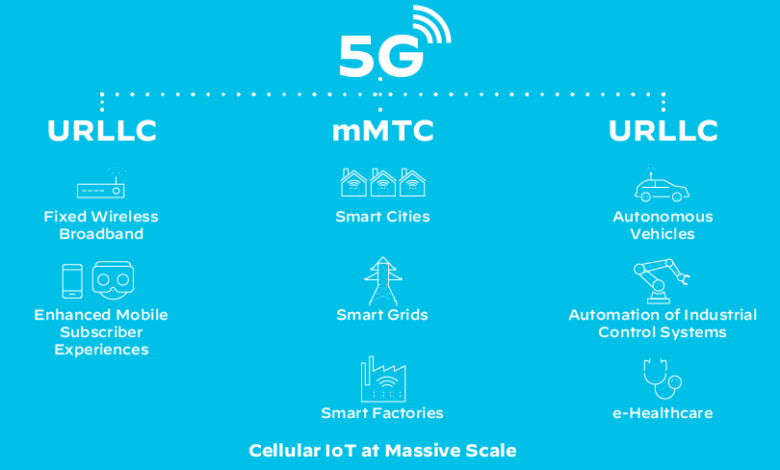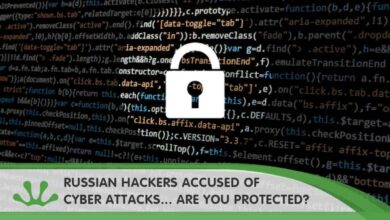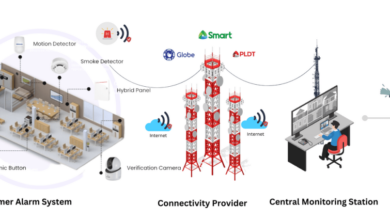
How 5G Technology Offers a Secure Network
How 5G technology offers a secure network is a critical aspect of its development. 5G’s advanced architecture introduces a new level of security challenges and opportunities. This blog post dives deep into the intricate security mechanisms and network enhancements that underpin 5G’s promise of a secure network.
From encryption protocols to network slicing, this exploration highlights the multifaceted approach to security in 5G. We’ll examine the crucial elements of user authentication, data integrity, and potential threats, offering practical insights into how 5G safeguards data and networks.
Introduction to 5G Security
G technology represents a significant leap forward in mobile communications, offering unprecedented speeds, low latency, and massive connectivity. This rapid evolution, however, introduces new security challenges that must be addressed proactively to ensure the integrity and reliability of the network. The fundamental architecture of 5G, relying on a distributed and complex system of nodes, introduces vulnerabilities that were less prominent in previous generations.
Protecting this intricate infrastructure is paramount to maintain public trust and ensure the secure delivery of services.The security of 5G networks is critical for several reasons. A compromised network can lead to data breaches, denial-of-service attacks, and unauthorized access to sensitive information. Protecting user privacy, maintaining the confidentiality of communications, and ensuring the integrity of data are all paramount in a 5G environment.
These considerations become even more critical as 5G networks become increasingly integrated into critical infrastructure and everyday life.
5G Network Architecture
G networks employ a complex architecture that extends beyond traditional cellular infrastructure. This architecture comprises various interconnected elements, including base stations, core networks, and user equipment (UEs). This distributed design presents novel security concerns that require meticulous attention to detail.
Key Security Challenges in 5G
The unique characteristics of 5G networks create a distinct set of security challenges. These challenges are different from those in previous generations of cellular technology and require innovative solutions. Key concerns include:
- Increased attack surface: The distributed nature of 5G networks, encompassing a wider range of devices and communication protocols, significantly expands the potential attack surface. This increased complexity necessitates a multi-layered security approach.
- Dynamic spectrum sharing: 5G networks utilize dynamic spectrum sharing, enabling them to utilize various frequency bands and potentially share them with other wireless technologies. This introduces the challenge of maintaining security across these dynamic, overlapping networks.
- Edge computing: The integration of edge computing in 5G networks brings computational power closer to the user, enabling faster data processing. However, this also introduces security concerns regarding the security of data processed at the edge.
- IoT integration: 5G networks are designed to support the massive growth of Internet of Things (IoT) devices. The potential for security vulnerabilities in these connected devices creates a critical security concern that needs to be addressed through robust security standards.
Layers of a 5G Network and Their Security Concerns
The multifaceted nature of a 5G network necessitates a layered security approach. Each layer presents unique security considerations that need careful evaluation and mitigation strategies.
| Layer | Description | Security Concerns |
|---|---|---|
| Radio Access Network (RAN) | This layer encompasses the base stations that communicate directly with user devices. | Compromised base stations could facilitate unauthorized access, eavesdropping, or manipulation of communications. Physical security of the base stations is also critical. |
| Core Network | This layer manages the network’s core functions, including user authentication, mobility management, and data routing. | Security breaches in the core network can lead to unauthorized access to user data, disruptions in service, or manipulation of network traffic. |
| User Equipment (UE) | This layer includes the devices that users interact with, such as smartphones and IoT devices. | Vulnerabilities in user equipment can allow attackers to gain unauthorized access to sensitive data or to disrupt network communications. Ensuring the security of the software and firmware on these devices is critical. |
| Network Function Virtualization (NFV) | This layer enables the virtualization of network functions, enhancing network flexibility and efficiency. | Security of virtualized network functions is crucial. Vulnerabilities in the virtualization layer can lead to security breaches across the network. |
Enhanced Security Mechanisms in 5G
- G networks, with their increased bandwidth and lower latency, are poised to revolutionize various industries. However, this enhanced speed and capacity also necessitate robust security measures to protect sensitive data transmitted across the network. This increased demand for security is met with sophisticated security mechanisms that build upon the foundations of 4G while introducing innovative solutions.
- G security architecture incorporates a multi-layered approach, combining advanced encryption, stringent authentication protocols, and granular access control to safeguard data integrity and user privacy. This approach is crucial in the face of growing cyber threats and increasing data volumes.
Advanced Encryption Methods in 5G
G leverages modern cryptographic algorithms to protect data during transmission. These algorithms, often employing symmetric and asymmetric key cryptography, ensure confidentiality and integrity of the exchanged data. Advanced encryption standards, such as AES-256, are employed to encrypt user data and network traffic. This strong encryption mitigates the risk of unauthorized access and data breaches. The use of these sophisticated algorithms ensures that even if an attacker intercepts the data, they are unable to decrypt it without the proper keys.
Authentication Protocols in 5G Security
Authentication protocols are paramount for verifying the identity of users and devices accessing the 5G network. These protocols are designed to prevent unauthorized access by ensuring that only legitimate users and devices are granted access to the network. For instance, the 5G network utilizes a combination of user credentials, device certificates, and network-based authentication methods to authenticate users and devices.
This multi-layered authentication significantly reduces the risk of impersonation and unauthorized network access.
Access Control Mechanisms in 5G Networks
Access control mechanisms define the level of access that different users and devices have to the 5G network resources. These mechanisms are essential for restricting access to sensitive data and network functionalities. 5G networks employ granular access controls, allowing administrators to precisely define which users and devices can access specific parts of the network. This fine-grained control ensures that only authorized users and devices can access critical data and resources, mitigating the risk of unauthorized access and misuse.
5G promises a robust and secure network, but vulnerabilities like those recently discovered in Azure Cosmos DB, detailed in Azure Cosmos DB Vulnerability Details , highlight the ongoing need for vigilance in cloud-based systems. While 5G’s advanced encryption and data protection mechanisms aim to mitigate risks, understanding and addressing potential weaknesses in related services is crucial for maintaining a truly secure network environment.
Secure Data Transmission in 5G
Secure data transmission in 5G relies on a combination of encryption, authentication, and access control. The security protocols employed ensure the confidentiality, integrity, and availability of data throughout the transmission process. This includes the use of secure communication channels, ensuring that data is protected against eavesdropping and tampering. The implementation of robust security protocols and encryption mechanisms protects the integrity of the transmitted data.
Comparison of 4G and 5G Security Protocols
| Feature | 4G | 5G |
|---|---|---|
| Encryption | Generally uses AES-128 or similar, potentially weaker algorithms | Employs more robust algorithms like AES-256, potentially using elliptic curve cryptography for key exchange |
| Authentication | Relies on user credentials and network-based authentication methods | Utilizes more sophisticated methods incorporating device certificates and advanced authentication mechanisms, improving user authentication |
| Access Control | Less granular access control, possibly limited to network access levels | Implements more granular access controls, allowing for fine-tuning access to specific resources and services |
| Data Integrity | Uses checksums and message digests for data integrity | Employs advanced message authentication codes and digital signatures to ensure data integrity, potentially using stronger hashing algorithms |
This table highlights the advancements in security protocols between 4G and 5G. The increased sophistication in encryption, authentication, and access control in 5G reflects the growing need for secure data transmission in the context of modern applications.
Network-Level Security Enhancements

G networks, with their enhanced speed and capacity, introduce new complexities in security. Protecting these networks requires sophisticated strategies that go beyond traditional approaches. Network-level security enhancements are crucial in ensuring the integrity and confidentiality of data traversing the 5G infrastructure. These enhancements are not just about adding more layers of security; they’re about fundamentally changing how the network itself operates to prevent and mitigate threats.
Network Slicing for Secure Segmentation
Network slicing, a key feature of 5G, allows the creation of virtual networks tailored to specific needs. This virtualization allows for the isolation of different services and users, effectively creating secure segments within the overall network. This segmentation limits the impact of a security breach in one slice to other slices. For instance, a slice dedicated to critical infrastructure could be completely isolated from a slice handling general consumer traffic.
This isolation minimizes the potential for a cyberattack to propagate across the entire network.
Network Virtualization and Security
Network virtualization, central to 5G, significantly impacts security. Virtualization creates a flexible and dynamic environment where network functions can be deployed, modified, and scaled independently. This flexibility allows for rapid deployment of security solutions and updates. Moreover, the ability to isolate virtualized network functions (VNFs) enhances security by creating isolated environments for sensitive data and applications. This isolation is crucial in preventing attacks that could compromise multiple services.
Software-Defined Networking (SDN) for Improved Security
Software-Defined Networking (SDN) provides a centralized control plane for managing network resources. This centralized control enables automated security policies to be implemented and enforced consistently across the network. SDN’s programmability allows security administrators to rapidly deploy and adjust security measures in response to evolving threats. Real-time threat detection and response capabilities are further enhanced by the centralized control, enabling the network to adapt and mitigate attacks more effectively.
Security Information and Event Management (SIEM) in 5G
Security Information and Event Management (SIEM) systems play a critical role in monitoring and analyzing security events across the 5G network. These systems collect and correlate logs from various network devices and applications to identify suspicious activities and potential threats. SIEM solutions can analyze massive volumes of data to detect anomalies and potential intrusions, providing a comprehensive view of security posture.
This real-time monitoring allows for rapid response to security incidents and helps to prevent breaches.
Security Threats and Mitigation Strategies
| Security Threat | Mitigation Strategy |
|---|---|
| Unauthorized Access | Strong authentication mechanisms, access control lists, and network segmentation |
| Denial-of-Service (DoS) Attacks | Traffic filtering, intrusion detection systems, and load balancing |
| Malware Injection | Endpoint security solutions, network intrusion prevention systems, and regular security updates |
| Man-in-the-Middle (MitM) Attacks | Secure communication protocols (e.g., TLS/SSL), encryption, and secure key management |
| Data Breaches | Data encryption at rest and in transit, secure storage solutions, and regular data backups |
User Authentication and Access Control
G networks demand robust security measures to prevent unauthorized access and ensure the integrity of data transmitted. A critical component of this security framework is user authentication and access control, meticulously designed to verify user identities and restrict access to 5G resources based on defined permissions. This process is paramount for maintaining the confidentiality, availability, and integrity of the network and the services it provides.User authentication is the process of verifying the identity of a user attempting to access 5G services.
Effective access control mechanisms determine which resources a user is permitted to access, thus mitigating potential security breaches. This ensures only authorized users can utilize 5G services and resources, safeguarding against unauthorized activities.
Authentication Methods for 5G Users
Various authentication methods are employed to verify user identities in 5G networks. These methods often leverage a combination of techniques to enhance security and provide a multi-layered approach to authentication.
- Password-based authentication: Traditional password systems, though vulnerable to attacks, are still frequently used in 5G networks. They rely on strong passwords and regular password updates to prevent unauthorized access. This is often combined with multi-factor authentication (MFA) for enhanced security.
- Multi-factor authentication (MFA): This method requires users to provide multiple pieces of evidence to prove their identity. This could include something they know (password), something they have (security token), or something they are (biometric data). MFA significantly strengthens security by adding layers of verification.
- Public Key Infrastructure (PKI): PKI-based authentication utilizes digital certificates to verify user identities. This approach relies on a trusted authority to issue and manage digital certificates, ensuring the authenticity of the user attempting to access the network.
- Biometric authentication: Using biometric characteristics like fingerprints or facial recognition, this method adds an extra layer of security by linking a user to a unique biological identifier. This reduces the risk of unauthorized access.
Access Control Methods in 5G
Access control in 5G networks involves defining and enforcing policies that dictate which users have access to specific resources. This is essential for maintaining network security and preventing unauthorized use of services.
- Role-based access control (RBAC): This approach assigns users to roles with predefined access permissions. Users with specific roles can access only the resources associated with their assigned roles. This approach simplifies management and ensures consistent access control across the network.
- Attribute-based access control (ABAC): This method allows for more granular control over access based on attributes associated with users, resources, and the environment. ABAC is particularly useful in dynamic environments where access needs to adapt to changing circumstances.
Authorization Models in 5G Security
Authorization models dictate how access control policies are applied in 5G networks. Different models provide varying levels of flexibility and granularity in controlling access to network resources.
- RBAC Model: Users are assigned to roles, and roles are granted specific permissions. This approach simplifies access management and enforces policies consistently across the network.
- ABAC Model: Access decisions are based on attributes of the user, resource, and environment. This allows for dynamic and fine-grained control over access, particularly useful in complex or evolving environments.
User Roles and Access Permissions in 5G
The table below illustrates different user roles and their corresponding access permissions in a 5G network. This example demonstrates how specific roles have specific levels of access to various network services.
| User Role | Access Permissions |
|---|---|
| Network Administrator | Full access to all network resources, including configuration, maintenance, and user management. |
| Network Operator | Limited access to network configuration and monitoring, restricted from user management. |
| Subscriber | Access to subscribed services and resources, including data transmission and voice calls. |
Data Integrity and Confidentiality: How 5g Technology Offers A Secure Network
Protecting data in the 5G network is paramount. Data integrity ensures the accuracy and consistency of information throughout its lifecycle, while confidentiality safeguards it from unauthorized access. These principles are crucial for building trust and ensuring the reliability of 5G services. Robust security mechanisms are essential to counter potential threats and vulnerabilities.
5G promises a more secure network, boosting data transmission speed and reliability. However, robust security measures are crucial, especially when considering the need to deploy AI code safety tools like those discussed in Deploying AI Code Safety Goggles Needed. This ensures the integrity of the network, even with advanced threats. Stronger coding practices are key to maintaining the security that 5G’s speed and reliability bring.
Techniques for Ensuring Data Integrity in 5G
Data integrity in 5G is maintained through various techniques that detect and prevent unauthorized modifications to transmitted data. These mechanisms ensure the data received is identical to the data sent. Hashing algorithms are commonly used, where a unique digital fingerprint (hash) is generated for each data block. Any alteration to the data will result in a different hash, thus alerting the recipient to tampering.
Message Authentication Codes (MACs) are another key element, adding an authentication tag to the message that only the intended recipient can verify. Digital signatures, using asymmetric cryptography, further authenticate the sender and guarantee the message’s origin.
Methods for Maintaining Data Confidentiality in 5G
Confidentiality in 5G protects data from unauthorized access by encrypting it during transmission. Encryption transforms data into an unreadable format (ciphertext) using cryptographic keys. Advanced encryption standards like AES (Advanced Encryption Standard) and 3DES (Triple DES) are widely used to achieve high levels of confidentiality. End-to-end encryption, where data is encrypted from the source to the destination, ensures only authorized parties can access it.
This approach is particularly crucial for sensitive data like user credentials or financial transactions. Furthermore, data at rest is protected by encryption at storage, employing similar cryptographic methods.
Role of Cryptography in Securing Data in 5G Networks
Cryptography plays a central role in securing data in 5G networks. It underpins the techniques for ensuring data integrity and confidentiality. Algorithms like RSA (Rivest-Shamir-Adleman) and ECC (Elliptic Curve Cryptography) are essential for generating and managing cryptographic keys. These keys are used to encrypt and decrypt data, authenticate users, and digitally sign messages. The strength of cryptographic algorithms directly impacts the security of the entire network.
Choosing appropriate cryptographic algorithms and key management procedures is critical to maintain the security posture.
5G’s robust infrastructure is a game-changer for secure networks, offering significantly improved data encryption and reduced latency. This enhanced security is crucial, especially considering recent developments like the Department of Justice Offers Safe Harbor for MA Transactions Department of Justice Offers Safe Harbor for MA Transactions , which highlights the need for dependable systems. Ultimately, 5G’s capacity to deliver a secure and reliable platform makes it a vital component of modern digital infrastructure.
Comparison of Different Data Protection Mechanisms for 5G
Various data protection mechanisms offer different levels of security and performance characteristics. For instance, symmetric encryption, employing the same key for encryption and decryption, is faster but requires secure key exchange. Asymmetric encryption, utilizing separate keys for encryption and decryption, is more secure for key exchange but slower. Hashing algorithms focus on detecting data alterations, while digital signatures verify the authenticity and integrity of data.
Choosing the right mechanism depends on the specific security requirements and the type of data being protected. A comprehensive security strategy often involves a combination of these mechanisms for optimal protection.
Data Breach Scenarios in 5G and Their Impacts
The table below Artikels potential data breach scenarios in 5G networks and their associated impacts. Understanding these scenarios helps in developing appropriate mitigation strategies and incident response plans.
| Data Breach Scenario | Possible Impacts |
|---|---|
| Unauthorized access to user data | Reputational damage, financial loss, identity theft, legal liabilities |
| Data interception during transmission | Compromised sensitive information, unauthorized access to personal data, potential for fraud |
| Denial of service attacks | Service disruption, loss of revenue, operational inefficiency, loss of customer trust |
| Compromised network infrastructure | Data breaches, service outages, financial losses, reputational damage |
| Insider threats | Data leakage, unauthorized access to sensitive information, disruption of services |
5G Security Threats and Mitigation
The allure of 5G’s blazing-fast speeds and enhanced connectivity brings with it a heightened need for robust security measures. While 5G offers revolutionary capabilities, its architecture also introduces new attack vectors and vulnerabilities. Understanding these threats and implementing effective mitigation strategies are crucial to ensuring the integrity and reliability of 5G services.
Major Security Threats Targeting 5G Networks
G networks face a diverse range of threats, many stemming from the network’s increased complexity and reliance on interconnected devices. These threats can range from sophisticated cyberattacks to vulnerabilities in the network infrastructure itself. Key threats include unauthorized access attempts, denial-of-service attacks, and data breaches. Moreover, the increased use of IoT devices in 5G networks introduces new avenues for exploitation.
Impact of Security Threats on 5G Services
Security breaches in 5G networks can have significant consequences, impacting various aspects of the services provided. Disruptions to communication, unauthorized access to sensitive data, and service outages can lead to substantial financial losses and reputational damage for operators. Critically, the reliance on 5G for critical infrastructure necessitates a high level of security to prevent catastrophic consequences in case of attack.
Strategies to Mitigate Potential Security Vulnerabilities in 5G
A multi-layered approach to security is essential to mitigate potential vulnerabilities in 5G. This includes robust access control mechanisms, encryption protocols, intrusion detection systems, and continuous monitoring. Regular security audits and vulnerability assessments are vital to identify and address potential weaknesses proactively. Furthermore, educating users about security best practices is crucial for preventing attacks initiated through user-facing applications or devices.
Steps to Respond to Security Incidents in 5G
Establishing a well-defined incident response plan is paramount for effective handling of security incidents. This plan should include procedures for detection, containment, eradication, recovery, and post-incident analysis. Prompt identification and isolation of compromised systems are critical to preventing further damage. Furthermore, rigorous documentation of the incident and lessons learned is vital for future prevention.
Comprehensive Overview of Potential 5G Attacks and Countermeasures
| Potential Attack | Description | Countermeasure |
|---|---|---|
| Denial-of-Service (DoS) Attacks | Overwhelming the network with traffic to prevent legitimate users from accessing services. | Implementing robust traffic filtering, intrusion detection systems, and load balancing mechanisms. |
| Man-in-the-Middle (MitM) Attacks | Interception of communications between two parties without their knowledge. | Employing end-to-end encryption and secure authentication protocols. |
| Unauthorized Access | Gaining access to network resources without proper authorization. | Strong authentication mechanisms, access control lists, and regular security audits. |
| Data Breaches | Unauthorized access and exfiltration of sensitive data. | Data encryption, secure storage, and access controls; adherence to industry standards. |
| Eavesdropping Attacks | Interception of data transmitted over the network. | Encryption and secure tunneling protocols. |
Future Trends in 5G Security
The evolution of 5G technology brings forth exciting opportunities, but also necessitates a proactive approach to security. As 5G networks integrate with emerging technologies, the threat landscape will undoubtedly change, demanding a robust and adaptable security strategy. Addressing these evolving challenges is crucial for ensuring the continued trust and reliability of 5G communications.The ongoing integration of artificial intelligence (AI) and machine learning (ML) into 5G infrastructure and applications introduces both exciting possibilities and new security concerns.
For instance, AI-powered network management systems could enhance efficiency, but also become vulnerable to malicious attacks targeting the underlying algorithms. Similarly, the rise of the Internet of Things (IoT) necessitates robust security measures to protect the vast network of interconnected devices. These devices, often with limited processing power and memory, may be particularly vulnerable to exploitation. These developments highlight the need for a comprehensive security framework that evolves alongside the technological advancements driving 5G.
Emerging Security Challenges in 5G Evolution
The integration of AI and ML into 5G network management systems and applications introduces novel security challenges. Malicious actors could potentially exploit vulnerabilities in these AI systems to disrupt network operations or gain unauthorized access to sensitive data. Furthermore, the expanding IoT ecosystem presents a considerable attack surface. The sheer volume of interconnected devices, many with limited security capabilities, creates a significant risk of widespread compromise.
Additionally, the increasing reliance on cloud-based services for 5G functionalities raises concerns about data breaches and unauthorized access to cloud infrastructure.
Potential Impact of New Technologies on 5G Security
New technologies are reshaping the 5G landscape, presenting both opportunities and challenges for security. The growing reliance on software-defined networking (SDN) and network function virtualization (NFV) introduces potential vulnerabilities if not properly secured. Moreover, the deployment of edge computing for 5G applications introduces a new layer of complexity in terms of security. The proximity of edge servers to end-users presents new opportunities for attackers, while the need for secure data transmission and processing at the edge demands innovative security protocols.
Enhanced 5G Architecture for Improved Security, How 5g technology offers a secure network
Robust security measures must be incorporated into the 5G architecture from the outset. This includes implementing end-to-end encryption for data transmission, employing strong authentication mechanisms at all access points, and incorporating intrusion detection and prevention systems. Additionally, the development of secure edge computing platforms is critical to protect sensitive data processed at the network edge. Furthermore, the architecture should prioritize security by design, integrating security considerations into every stage of the 5G network development lifecycle.
Emerging Security Protocols and Standards for 5G
The development of new security protocols and standards is vital to ensure the secure operation of 5G networks. One emerging area is the use of blockchain technology for enhanced data integrity and security. Moreover, secure communication protocols that are optimized for the unique characteristics of 5G, such as low latency and high bandwidth, are being actively developed.
Furthermore, international collaboration and standardization efforts are crucial for creating a consistent and robust security framework across different 5G deployments.
Potential Future Security Threats and Mitigation Strategies
| Potential Threat | Likely Mitigation Strategy ||—|—|| AI-powered attacks on network management systems | Robust AI-based threat detection and mitigation systems; continuous security updates and patching. || IoT device vulnerabilities | Implementing strong security protocols and encryption at the device level; regular security audits and firmware updates; implementing secure communication channels between IoT devices and the network. || Cloud-based data breaches | Implementing multi-factor authentication, encryption of data at rest and in transit, and robust access control measures in cloud environments; conducting penetration testing and vulnerability assessments.
|| Advanced persistent threats (APTs) targeting 5G infrastructure | Enhanced security monitoring and threat intelligence gathering; proactive security measures, including threat hunting and incident response planning; developing sophisticated threat-detection mechanisms capable of identifying zero-day exploits. |
Closing Notes

In conclusion, the secure network capabilities of 5G are not just a promise, but a tangible reality. By understanding the layered security approach, from advanced encryption to network segmentation, we gain valuable insights into the future of secure communication. This technology presents a compelling solution to the evolving security landscape.
Detailed FAQs
What are the main security challenges unique to 5G?
5G’s wider bandwidth, increased device connectivity, and reliance on new technologies introduce unique security vulnerabilities, such as potential for more sophisticated attacks and increased attack surface. Ensuring the security of this interconnected system requires novel solutions.
How does network slicing contribute to secure network segmentation?
Network slicing allows for the creation of isolated virtual networks within the 5G infrastructure. This segmentation isolates traffic and resources, preventing unauthorized access between different slices and improving overall network security.
What are some common data breach scenarios in 5G and their impacts?
Common data breach scenarios in 5G include unauthorized access to user data, eavesdropping on sensitive communications, and denial-of-service attacks. These can lead to significant financial losses, reputational damage, and potential harm to users.
What are emerging security challenges in the evolution of 5G?
As 5G evolves, new security challenges emerge, including the integration of new technologies, the increasing complexity of the network, and the potential for new attack vectors. Addressing these requires proactive security measures.





